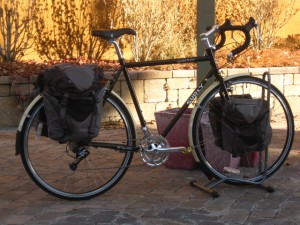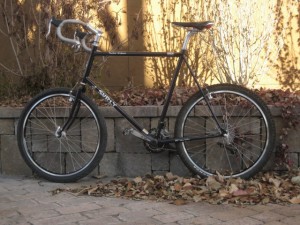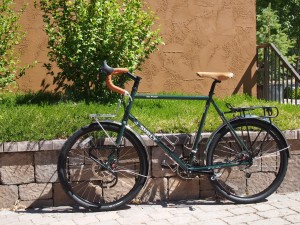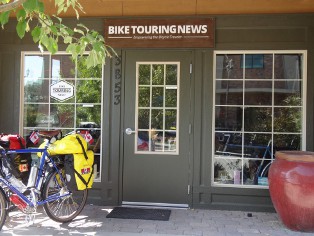Every size of the Long Haul Trucker bicycle, from the tiny 46cm bike to the gargantuan 64cm bike is available with 26″ wheels. 56cm and larger frames also come in 700c wheel versions while 54cm and smaller bikes only come with 26″ wheels. Why do they do that? Why can’t you buy a smaller bike with 700c wheels? And how do I choose between 26″ and 700c wheels on my 62cm Long Haul Trucker?
First, some bike design theory:
As a bike frame shrinks in size 700c wheels become problematic in a couple of ways. Georgina Terry from Terry Bicycles does a fantastic job of qualifying those problems in her videos about Bicycle Design
With a given wheel size- in this case 700c- there is a limit to how low the top tube can be before you run out of head tube and how short it can be before the rider’s foot starts hitting the front wheel.
Some bike manufacturers call some of their smaller bikes “women’s specific” and paint them in girly colors, which is nothing less than a marketing gimmick. Mainstream bike companies assume that the market will demand 700c wheels on their “road bikes” and so they compromise the design of the smaller bikes by changing the angle of the seat tube to make the top tube shorter and they change the angle of the headtube to mitigate toe overlap with the front wheel, which also helps make the top tube shorter.
A better way, and the way good bike designers like Terry, Rivendell and Surly do it is to change to a smaller size wheel as the frame size shrinks. Rivendell and Surly change both front and rear wheel sizes while Terry uses a smaller front wheel with a 700c rear wheel.

A truism I hear all the time is that 700c wheels are faster than 650b or 26″ wheels. But I don’t buy it. That’s what they make gears for. A 26″ wheel will be spinning faster than a 700c wheel would be at the same velocity so the rider might be in a higher gear. Surly makes the analogy of a tractor compared to a Formula One car….the controlling factors being gearing, suppleness and quality/type of tire and the motor.
What about handling of a bike with the smaller tires? Georgina Terry simply says that the front end is designed for the a smaller tires and so the handling isn’t twitchy. One of those design features taken from the Surly geometry charts is a slightly more slack head tube on the 26″ bikes which results in a similar trail when compared to the 700c bikes. I do think that a bike with 26″ wheels rides differently than one with larger wheels, simply because of that gyroscopic thing.
The reason Surly decided a couple years ago to offer every size LHT and Disc Trucker in 26″ wheel versions is that the 26″ wheel size is more ubiquitous around the world and replacement wheels and tires should be easier to find. So if you plan on touring in countries outside the US, 26″ wheels might be a good way to go. Come to think of it, there may more 26″ wheels and tires available here too in out of the way places. I’m reminded of the story of the couple traveling between Portland and Boise when they accepted a ride in a pickup truck and her bike fell out at 60 MPH. The rear wheel was ruined but their hosts had an old mountain bike in a shed from which she was able to salvage a serviceable wheel.
So, to summarize:
-Small bike…small wheels
-Larger bike and desire to find replacement wheels/tires wherever one may tour (or desire to run really fat tires) …26″ wheels.
-If you think 26″ wheels on bigger bikes look funny….700c wheels
-If you are convinced that 700c wheels are somehow faster…get those (assuming, of course, you think going faster is a good thing)




K.G. Thornburg April 9, 2013, 4:01 pm
I’m a 5’9″ ish guy. I walked into NorthCentralCyclery in Dekalb, Il to look at Long Haul Truckers. Jeff pointed me to a 52cm Trucker with 26″ tires and wheels. Looked tiny. Took a test spin. No toe overlap, responsive, comfy, kind of a”old sportscar” feel. I liked it, alot. I had them put on Big Apples, my old B-17, and been enjoying my “slow” 52cm, 26″ ever since. I can go just as fast as anybody else, but why? Just ride!
Love your site, keep it up! K.G. in Wheaton Il.
Bike Hermit April 10, 2013, 1:18 pm
Thanks so much K.G.! An LHT with Big Apples….can’t go wrong.
John Rausch April 14, 2013, 9:41 am
I believe that you miss an important point, that of tire availability. If you like riding on skinny tires say 23mm wide, the choices are much greater if you have 700C rims. The converse is also true. There are many more choices of wide rough road tires for the 26 inch rim. Over the years this problem became apparent as the availability of quality of skinny 27 inch tires waned.
Tim July 13, 2014, 12:25 pm
Question… Why would you put 700-23 on a LHT, or anything less than 32’s? Touring with that setup would be a nightmare.
Phillip Bissell April 15, 2013, 11:06 pm
Jim, your summary is so manifestly correct that you have said all that need be said about wheel sizes. Me?. . . I go for 700C wheels on both road bicycles. My tourer has a 62cm frame; my daily road bike 58. Both a joy to ride.
But then, I have never ridden in countries other than Australia. If I did, then things could change.
Phillip Bissell
CJFilip April 16, 2013, 8:45 am
Bike falling out of truck at 60mph. http://shitbubbles.com/the-desert-hates-emma-pt-1/
Alan April 29, 2013, 7:23 pm
This article makes a guarded, but convincing argument that 700c are faster and have better rolling characteristics. I’ve tried both and have to say, annecdotally, that 700c seem faster. It’s not a huge difference, but is noticeable. Here’s the article:
http://cyclingabout.com/index.php/2011/12/700c-vs-26-inch-wheel-size-for-touring/
tony dadson October 18, 2013, 12:00 am
Jan heine’s tests in Bicycle Quarterly disprove your anecdotes
Craig Montgomery May 5, 2013, 11:46 am
I don’t think 700c is faster, just rolls better/longer. My buddy and I have been touring together for over 2 decades. He’s on a 700c All Rounder and I’m on a 26″ All Rounder. I’m always pedaling to keep up when he’s dilly-dallying down a shallow incline.
Carl Valero November 24, 2013, 5:04 pm
There’s two other essential parameters to consider when chosing a tire size : load size and road roughness. I chose 26″ when loaded with camping gear or/and when the road surface is bad with potholes and bumps/rocks. Inversely I take my 700 x 32c wheeled steed when I know I’ll be riding on smooth asphalt. But unlike many cyclists I’m lucky to be able to house several bikes.
All the best.
Tom February 16, 2014, 6:22 pm
I have also perceived differences between 26” tires and 700c tires on touring bikes. I found a 11.6 mi. loop near my house that I use to test bikes and tires, as well as general workouts. My conclusions are that with the right 26” tires, they are a match for similar 700c touring tires. Specifically Continental Sport Contact, in 26×1.6” and 700x37c have similar cross section with the 26” being a bit bigger, but in timing myself around the course, with what I hope are similar efforts, the time is identical. However, not all tires are created equal. Some feel to me like I threw out an anchor when I go up hill. I assume it is something in the tire construction. Other parameters are about the same.
Another fast, wide tire is the Vittoria Randonneur Hyper 700c. It comes in 32, 35 and 38mm widths and pretty well matches the advertised width. (The Conti Sport Contact 700x37c measures on my bike at 33mm wide. The Vittoria Randonneur Hyper 700x32c measures 33mm.) I am also experimenting with Vittoria Randonneur Pro 26×1.6” tires. They are a little different than the Hypers, a little heavier. I haven’t yet reached a conclusion about their relative speed.
Bottom line conclusion: in suitable tires, there isn’t much if any difference between similar 26” and 700c tires, but there appear to be more suitable 700c tires than 26” tires.
Of course, your mileage will vary.
tony May 17, 2015, 6:44 pm
I was rather hoping for a more rigorous discussion on factors such as Tyre contact patch shape, Tyre pressure, tread squirm etc
Not really an objective assessment is it…
Tom December 6, 2015, 9:02 pm
I rode a Bianchi Volpe forever, but then the derailer hanger twisted and I needed a bike to ride for commuting, so I stripped the Volpe, and put everything on a old Schwinn Mesa (steel frame w/26″wheels) with a Rock Shox SID, and V-brakes with roll-a-majigs. It was supposed to be temporary, but I really enjoy riding it. With 26×1.75 tires, it handles Pa roads better than the 700c’s I had, and wet/muddy gravel on the rail-trails I use to get to where I’m going. As I get older, comfort matters more then speed, so I’ll just stay to the right so the faster bikes can get around me.
Bike Hermit® December 7, 2015, 11:40 am
Tom, The best bike in the world is the one that gets ridden! Thanks for sharing.
rob September 10, 2016, 10:55 pm
if you are concerned about speed specifically, it appears that the 700c is faster. perhaps overall speed isn’t a concern and For most, it is not. This test concerns the mountain-bike folk primarily but I can’t see why this wouldn’t be somewhat relevant in the “touring” realm https://www.youtube.com/watch?v=kxfrykeSNCE
John October 7, 2016, 10:31 am
One thing is definite. A larger circumference wheel flattens out the road.
By that, I mean the bigger wheel doesn’t realize the imperfections in the terrain as does the small one. The tight wheel tends to get hung up in crevices and such where a broad wheel rolls smooth. This holds true on both road and trail.
John January 28, 2017, 1:36 am
Bicycle touring is an activity in which most riders eventually “own” their bike. By that, I mean each rider comes to customize his or her own bike in ways that are unique, sometimes subtle, and always … well … silly and fun and individualized. I’m getting my wife’s LHT with 26″ wheels ready for spring and noticed that I have room underneath for another water bottle cage. My wife is 5′ 2″ and the bicycle geometry which “fits” her would be nigh impossible by with 700 tires.
We should not worry about tire size. Just get on the bicycle and ride, ride, ride! Get a bike you like, make it your own and never look back. I’ve met quite a few folks touring around in Montana and Wyoming and really can’t remember which ones had 26″ versus 700c wheels. They were too busy fighting the wind, working their way up the pass, and looking forward to that beer at the end of the ride. I’m surprised, however, that this article fails to mention the added frame room (for accessories) available with the 26″ wheels. It’s substantial.
Dana January 13, 2018, 11:11 pm
I’m 6’4, @230. For touring and everyday use i prefer 26″ wheels and 2″ tires, for a number of reasons:
– a wider tire works better off-pavement, and I live down 5 miles of Kansas farm road. I know crushed rock trails can be pretty good, but 2″ tires still seem a better choice for them. If I were out touring, my choice would handle any poorer surface better.
– Of the commonly available tires (I’m thinking wal-mart and hardware stores), a 26×2 holds the most air. Boyles law say pressure and volume are inversely proportional, meaning I can run a lower air pressure (45psi with no load) and still haul my bulk and load well. This allows me to chose a schraeder valve tube, so I don’t have to mess with an adapter for an air hose, and it means a better ride, for less stress on spokes.
– this may be debateable, but I assume a 26″ wheel is stronger than a 700c wheel, all else being equal, because the spokes are shorter. Regardless, i wouldn’t have less than 36 spokes and would prefer 40.
–